How to Stop Food Aggression in Dogs in 8 Steps
- from Anja Boecker
- Updated: 17 August, 2023
Your dog growls whenever you approach his food bowl? In this article, you will learn how to prevent food envy in the first place, and what to do if your dog is already defending his food with his whole body.
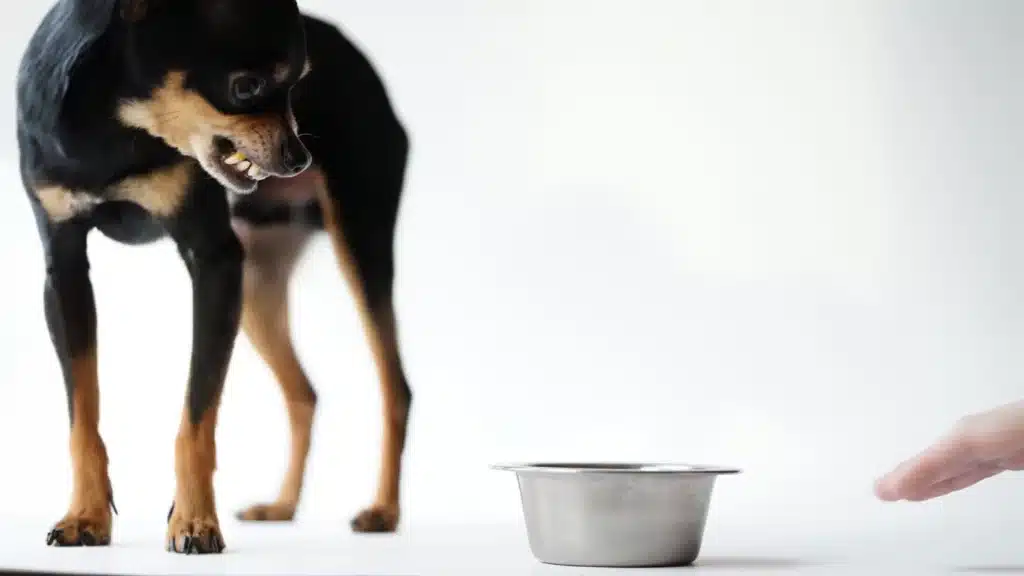
Food aggression is common in puppies, but also in adult dogs. It is usually caused by fear and insecurity.
What Is Food Envy in Dogs?
Imagine you have a delicious piece of cake and suddenly someone tries to take it away from you. You'd be quick to protect it, wouldn't you? Dogs have something similar, and it's called food envy.
If a dog considers his food or toy to be very valuable and does not want someone else to have it, he may growl, snap, or otherwise defend himself. This is his way of saying, "This is mine! No one else can have it!"
Sometimes this is because the dog has not eaten enough or has had bad experiences. But sometimes it is just part of his personality.
It is important to know that dogs are not "bad" or "greedy" when they show food envy. It is simply a way of communicating. If your dog exhibits this behavior, you should be patient and understanding, and perhaps seek the help of a pet trainer to better understand and control the behavior.
Why Do Dogs Defend Their Food?
Dogs defend their food for a variety of reasons, often related to their natural instincts and evolution:
- Survival instinct: In the wild, an animal's survival often depends on access to food. A wild animal that does not defend its food runs the risk of starvation. Although our pets no longer live in the wild, many of them still have this ingrained instinct to protect their resources.
- Uncertain Resources: Dogs that have had irregular access to food in the past (e.g., street dogs or dogs from poor housing) may learn to defend their food more intensely because they do not know when they will be fed next.
- Competition: In a household with several animals, a dog may feel that it must compete for food. This can lead to him defending his food from other animals.
- Personal space: Some dogs are more possessive by nature or are more protective of their personal space. They may defend not only their food, but also their toys, sleeping areas, or even people.
- Previous negative experience: A dog that has been disturbed or had food taken from it in the past may have learned to be more defensive about its food.
- Health reasons: In rare cases, pain or discomfort, especially in the mouth, can cause a dog to become more aggressive or defensive when eating.
It is important to emphasize that a dog who defends his food is not necessarily "vicious" or "dominant. He may simply be following his instincts or reacting to past experiences.
An understanding and patient approach is critical to helping a dog become less possessive or anxious about its food.
Why Is My Dog Showing Food Aggression?
In short: Your dog is protecting his resources. Feeding errors are usually the cause of this behavior. Your dog sees you approaching his bowl, bone, or treat.
He's afraid that you'll steal his treat. This is precisely the link that needs to be changed.
Your dog needs to learn that you are not taking anything away from him, but bringing him something much better. When your furry friend understands this, the food envy will stop. But this takes practice. Take the time to practice with your dog.
Very important: Be patient and loving. Then you will achieve your goal.
How Does Food Envy Develop in Dogs?
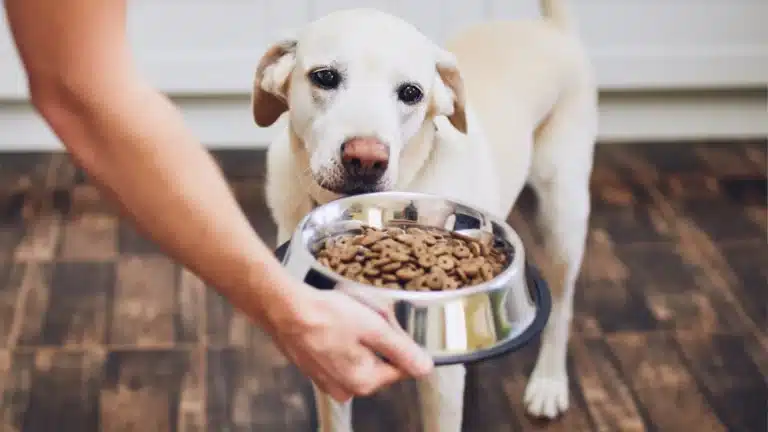
Food envy in dogs can have several causes. Here are some of the more common causes:
- Early experience: When a puppy grows up with many siblings and has to compete for food, it can learn to defend its food at an early age.
- Lack of resources: A dog that has not been fed regularly or enough in the past may develop food envy because it fears it will not get enough the next time.
- Budget changes: When a new dog or other animal enters the household and suddenly competes for food, it can cause food envy in the original dog.
- Character of the dog: Some dogs are naturally more possessive or insecure than others. These dogs may be more likely to develop food envy.
- Lack of socialization: Dogs that have not been properly socialized or have had bad experiences with other dogs regarding food can also develop food envy.
- Reinforcement by the owner: If the dog gets what it wants every time it growls or acts aggressively (e.g., when other dogs or people back off), it will learn that this behavior works.
- Sudden change of feed: If a dog is suddenly given a particularly tasty or different food, it can become very possessive.
To avoid or mitigate food envy, it's important to start early. If you have a puppy, get him used to you approaching him when he eats or even touching his food when you give him treats.
This will teach him that people around his food don't mean anything bad. It can also be helpful to teach the dog to wait on command before eating and to keep regular feeding times.
In severe cases of food envy, it may be wise to consult a professional dog trainer or behaviorist.
Typical Feeding Mistakes
Food envy often develops during puppyhood. The culprits are certain feeding mistakes.
1) Eating From the Same Bowl
Some breeders have the entire litter eat together from a ring bowl. Others feed the puppies close together. This looks cute. But it results in none of the dogs being able to eat relaxed.
Each puppy must compete with its siblings. They are competitors. Out of fear of not getting enough, puppies gobble down their food. This can lead to digestive problems such as flatulence.
2) Take Away Their Food
Another mistake is taking food away from a puppy. This is often done in the mistaken belief that the human is positioning himself as the "alpha" in the pack by this demonstration of power.
But this is not true: in a pack, every dog - regardless of its position - defends its prey.
Your pet is deeply insecure when his food is taken away: he feels that he is being watched while he eats and is afraid of losing his food to you at any time. His trust is destroyed.
Most quadrupeds show three reactions to this:
- They gorge: They eat as fast as they can.
- Fear: Some dogs may be afraid to even go to the bowl.
- Aggression: Still other four-legged friends will make typical threatening gestures to keep you away from their food.
This starts a dangerous chain reaction: At first, your pet may actually defend his food. Later, he may extend his defense to the empty bowl.
Then the food bowl becomes a sanctuary for your furry nose. Or even the whole room. Eventually, your dog will think he needs to protect himself from the unpredictable owner...
You see how quickly a situation like this can take on a life of its own. Don't let it get that far.
3) Ignoring Your Dog's Background
Maybe you've adopted a puppy or an adult dog from a shelter. It is wonderful to give a loving home to a four-legged friend with a past!
Dogs with a sad history have often starved to death. If your four-legged friend has been through this experience, he may be particularly protective of his precious resources.
Make sure he gets enough quality food that is appropriate for his age, activity level, breed, and health.
11 Tips for Food Envy
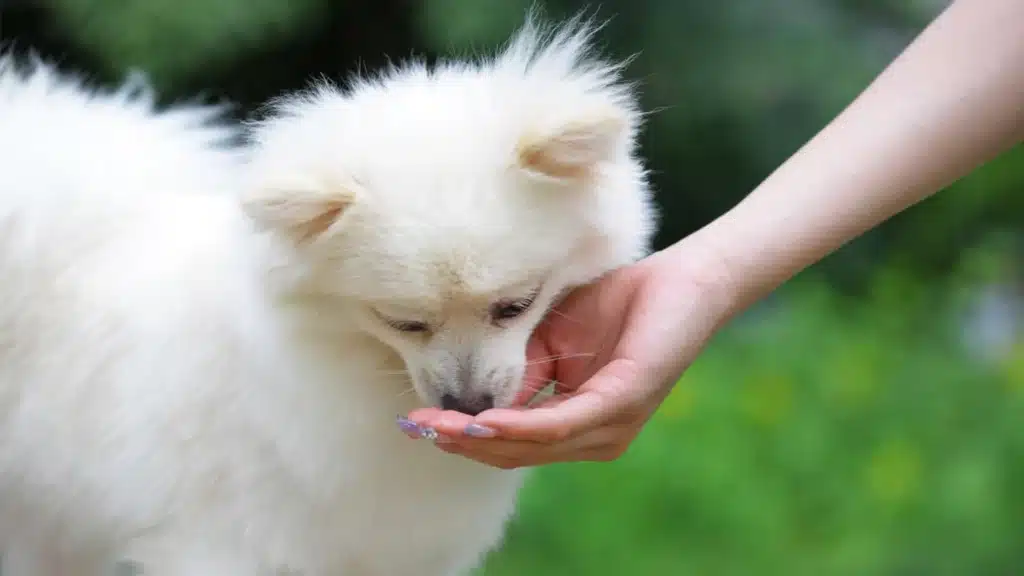
It's best if food envy doesn't happen in the first place. But even if your dog already shows food envy, you can change the unwanted behavior.
#1. Create a Safe Space
Provide a calm feeding environment. Feed your dog in a quiet place where he can relax and not feel the need to defend his food. Your dog should have peace and quiet at the food bowl. Avoid bustle and noise. Ideally, no one should walk around or past him while he is eating. Let him eat alone and undisturbed.
#2. Establish a Routine
Dogs love routine. Feed your dog at the same time and place every day. This gives him security and the feeling that his food will always be there.
- Set fixed feeding times: For many dogs, eating is the highlight of the day. Fixed feeding times give your furry friend structure. Your dog looks forward to it and learns that food will be in the bowl at a specific time.
- Always feed your pet in the same place: This can be a separate room or a fixed location. Dogs are creatures of habit. This is how your dog learns to trust you. He knows you will take care of his food. At the feeding station, he will feel safe and secure.
→ If you have more than one dog, feed them separately. Either choose different rooms or make sure there is enough space between them. They should not compete for food.
#3. Training + Food Dummy
Train your dog with commands like "sit" or "wait" before he gets his food. This will give you control and teach him patience.
A food dummy is a great way to build trust with your dog.
Fill a food dummy with treats. During your walk, drop the dummy. Let your dog run after it and bring it back. You can use the "Bring" command.
When your pet has mastered this task, he can take a treat from the dummy. Hold the treat firmly.
#4. Fill up the Bowl While Eating
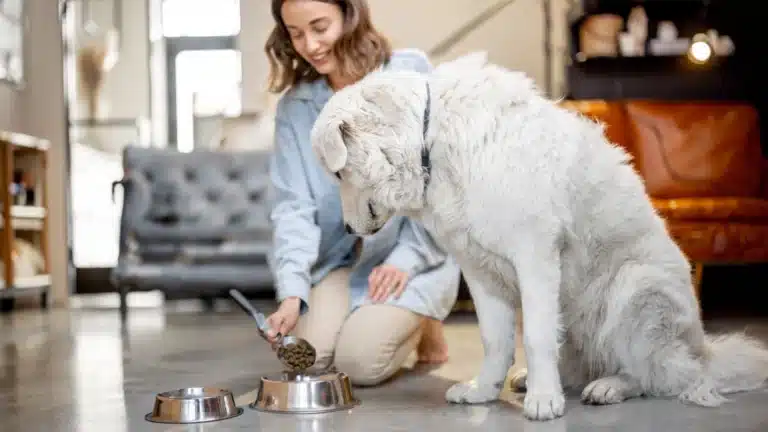
When your dog trusts that you will give him enough food, food envy will disappear. You can encourage this trust.
Follow these steps:
- Give your dog half of his usual amount of food in the bowl.
- Continue adding food as your dog eats from the bowl.
→ In this way, your pet will lose the fear that you will take something away. Instead, he develops the confidence that you will always put something tasty in his bowl. This strengthens his trust and your bond.
#5. Feed Your Dog Yourself + Hand Feeding
It is important for your dog to have a permanent caregiver who is responsible for feeding him at the beginning. If time or other constraints prevent you from doing this, another adult can be an alternative.
Hand feeding can help build trust between you and your dog. Occasionally feed your dog from your hand. This will teach him that you are not a threat to his food, but the source.
#6. Keep Small Children and Other Pets Away From Your Four-Legged Friend While Eating
Dogs that are jealous of food may bite in critical situations. Puppies have loud voices. They run around, are hectic, active and impatient. They may even reach into the dog's bowl.
In this case, your pet perceives the children as competitors for what may be his most important resource. He fears that his food will be taken away and reacts aggressively.
A simple solution is to keep children and other pets out of the room while your dog is eating. It usually only takes a few minutes to empty the bowl anyway.
#7. Positive Amplification
If you approach your dog while he is eating and he remains calm, reward him with kind words or a treat. This will help him associate your presence with something positive.
#8. Practice With Other People
Your dog accepts you at his food bowl? He is happy because he thinks you are bringing him something even better? Very good! Then you can practice this with other people. Train them first and give them clear instructions.
Your dog should have only positive experiences: If a human comes to my bowl, there's more tasty food. If your dog has boring dry food in his bowl, it can be a spoonful of his favorite dry food. Or a piece of raw meat.
Once all family members have trained with your dog, you may want to include a stranger in the training.
#9. No Hassle
If your dog growls or becomes aggressive, do not try to take away his food. This will only make the problem worse. Instead, try to gain your dog's trust over time.
#10. Do Not Take Away Resources
Avoid taking away toys or bones without offering a replacement. This can reduce the dog's sense of having to defend his resources.
#11. Search Tips
If the problem is severe or does not improve, a professional dog trainer or behaviorist should be consulted. Sometimes deep-seated behavior problems require specialized knowledge and procedures.
With patience and consistent training, many dogs can learn to be more relaxed and trusting of their food.
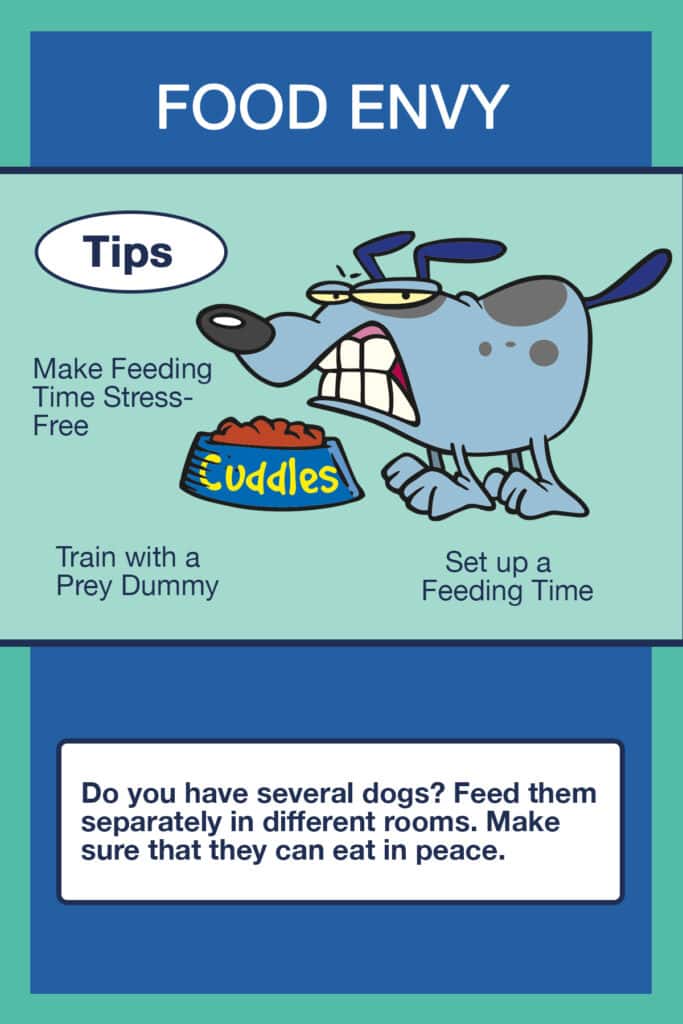
Proper Feeding With Multiple Dogs
If you have more than one dog, it's important to make sure each one gets a balanced, stress-free diet. Here are some tips on how to do this:
Separate Feeding Stations
To avoid conflicts, each dog should have its own feeding area far enough away from the others. This can be in different corners of the room, in different rooms, or in separate crates.
Simultaneous Feeding
Try to feed all the dogs at the same time so no one gets jealous or tries to steal food from the others.
Correct Quantity
Each dog should get the right amount of food for its age, size, and activity level. If you're not sure how much to give your dog, ask your veterinarian or check the food label.
Observe
Stay with the dog while he eats, at least until you are sure there is no conflict or food envy. This will allow you to intervene immediately in conflict situations.
No Treats or Extras During Feeding
Do not give treats or extras while the dogs are eating, unless all the dogs are getting the same thing at the same time. This will help prevent jealousy and conflict.
Resource Conservation
If a dog tends to defend his food, you should be extra careful and make sure other dogs don't get too close.
Remove Food Residue Immediately
When all the dogs have finished eating, you should remove any leftover food so that no dog tries to steal another dog's food.
Individual Feeding for Special Requirements
If a dog needs a special diet or medication, be sure to feed it quietly and separately from the other dogs to make sure it gets the right food.
Maintain Routines
Dogs love routines. It helps them feel safe and relaxed. Try to feed them at the same time and in the same way every day.
Positive Reinforcement
When dogs eat together quietly and peacefully, praise them for doing so. Over time, they will learn that good eating behavior leads to rewards.
Feeding multiple dogs can be challenging at first, but with patience, observation and consistency, it will soon become routine. It is important to provide security and ensure that each dog gets what it needs without stress or conflict.
Dog Bites Other Dog Out of Food Envy - What to Do?
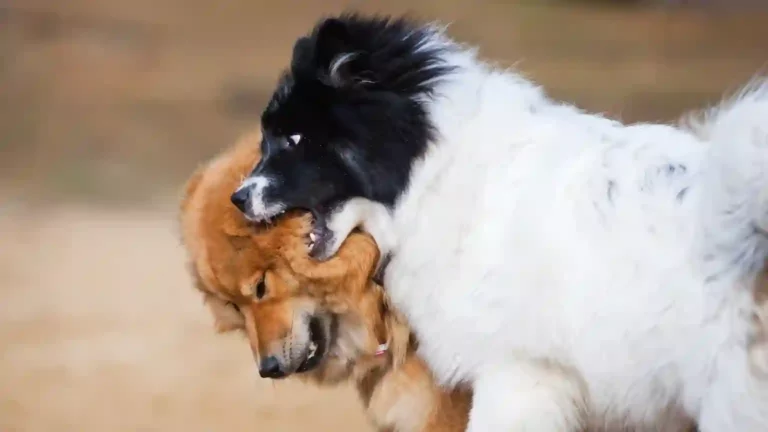
When a dog bites another dog out of food envy, it's not only a problem for the animals living together, but it can also be dangerous. Here are some steps and strategies you can follow to correct this behavior and make the situation safer:
The first thing you should do is make sure that the affected dog is fed separately from the other dogs. This can be in a separate room, in a different area, or at a sufficient distance. This will minimize the immediate risk of biting.
Work on getting your dog to listen to your commands, especially commands like "no," "off," or "sit. This will give you more control in situations where resource defense may occur.
If you notice your dog showing signs of aggression or food envy, try to distract him with a toy or other activity.
Always reward your dog for remaining calm and relaxed, especially in the presence of food or other resources.
Under the guidance of an experienced trainer, you can slowly introduce your dog to situations involving food in the presence of other dogs in a controlled manner. You should always be careful to encourage positive experiences and avoid negative interactions.
Learn to recognize the signs of food envy in your dog. These can include: staring, raising the hackles, growling, or eating too fast. If you notice these signs, you can intervene in time.
A professional dog trainer or animal behaviorist can provide valuable assistance. He or she can both teach the dog to change its behavior and help you learn the best strategies for dealing with the problem.
In some cases, aggressive behavior may be caused by health problems. A visit to the veterinarian can help rule out medical causes.
It is important to be patient and consistent and not ignore the problem. With the right approach and support, the dog's behavior can be improved, leading to a more peaceful coexistence with other dogs.
Can Food Envy Cause Problems?
Yes, food envy in dogs can lead to various problems, both for the dog itself and for other animals and people around it. Here are some possible problems that can be caused by food envy:
- Aggression towards other animals: A dog that is greedy for food may attack other dogs or animals that it perceives as a threat to its food source. This can result in bites and injuries.
- Aggression towards people: In some cases, a dog may also attack people if they approach its food or try to take it away.
- Stress for the dog: Food envy can be stressful for the dog. He may be in a state of constant tension and alertness when it comes to his food.
- Difficulties in living together: A dog that shows food envy can make it difficult to live with other dogs or animals in the same household.
- Health Problems: Dogs that eat too fast because of food envy can develop digestive problems. Fast eating can also lead to a dangerous condition called gastric torsion.
- Limited socialization: A food envious dog may have difficulty interacting with other dogs in social situations such as dog parks or meetings because he is always on guard.
- Owner-Dog Relationship: Food envy can put a strain on the relationship between dog and owner, especially if the owner doesn't know how to handle it or uses negative punishment to "solve" the problem.
It is important to recognize food envy early and deal with it appropriately to avoid or minimize these problems.
With the right approach and possibly the help of a professional trainer, food envy can often be reduced or even completely eliminated.
How to Stop Food Aggression in Dogs: How Long Does It Take?
It depends on your dog's age. A puppy learns quickly that there is no reason for food aggression. It usually takes only a few days.
An older quadruped, where the false imprint has been present for some time, will take considerably longer. Weeks or months may pass.
Important: Always give your dog the pleasant experience of you not taking anything away, but bringing food and replenishing it. Make sure your food delivery is a significant increase.
Conclusion
Food envy is usually the result of false imprinting. This often happens in puppyhood. With love and patience, you can influence your dog's behavior and change it for the better.
Practice with your pet regularly and get him to trust you. You can do this by showing your dog that you are not taking anything away from him, but bringing him even better food.
You can also use these tips if your dog is fiercely protective of not only his food, but also his toys.
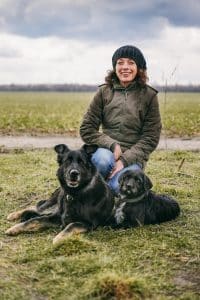
My name is Anja Boecker, and I am a certified dog trainer and behavior consultant. With these articles, I want to help you to understand your dog better and to build an inseparable bond.
Share Now:


Have thrown a Gutti to my bitch during a common dog walk with several dogs, another bitch was faster and ate it, since then there is a food envy when walking with other dogs, for example, when I reach into the bag and another dog comes running to me, or another dog wants to my food bag. Then she becomes aggressive. What can I do.
It looks like your dog has developed food envy or ownership envy as a result of the treat event. Here are some tips:
Basic Training: Refresh Basic Training, such as Come, Sit, Stay. First alone at home and then outdoors. This will help keep their attention on you and get the impulsive behavior back under control.
Food Bag Training: Now extend the training into food bag training by reaching into the food bag but not taking out any food. Reward your dog with treats or positive reinforcement when she stays calm and does not act aggressively, first without in the presence of other dogs, then with by reaching into the bag again but not taking out a treat and rewarding only your dog when she stays calm.
Letting Go Training: Practice swapping the toys or things that belong to your dog so that every time she lets go of a toy, you reward her with a treat. You can also do this with another treat. This will help her let go and learn that she will get something similar or better when she voluntarily lets go of her previous "property".
Controlled environment: Start training in a quiet environment with few distractions and gradually increase the difficulty by training in the presence of other dogs.
If the problem is more severe or does not improve, it would be advisable to consult a professional dog trainer or behavior therapist.